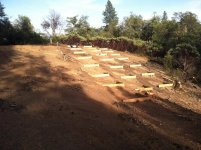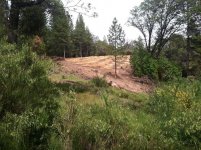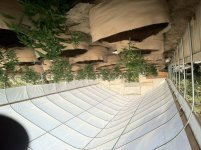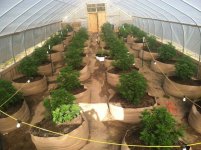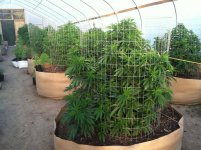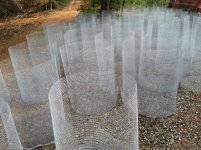C
-
Happy Birthday ICMag! Been 20 years since Gypsy Nirvana created the forum! We are celebrating with a 4/20 Giveaway and by launching a new Patreon tier called "420club". You can read more here.
-
Important notice: ICMag's T.O.U. has been updated. Please review it here. For your convenience, it is also available in the main forum menu, under 'Quick Links"!
You are using an out of date browser. It may not display this or other websites correctly.
You should upgrade or use an alternative browser.
You should upgrade or use an alternative browser.
C
caseyjones123
My spelling was wrong..auto spell correct sucks. Anyhow Is "leaf molddamn that looks nice. are the 7x7 planter/mounds 3 yards each? Awesome idea with the leaf mould mulch, how does that stuff work? how many inches do you put over the soil?
Am starting with 2-3 inches of mulch, as for gathering this stuff is labor intensive. Scraping top leaves and sticks away to get to the humus layer , or the more decomposed material
Leaf mold is a form of compost produced by the fungal breakdown[1] of shrub and tree leaves, which are generally too dry, acidic, or low in nitrogen for bacterial decomposition.
Leaf Nutrition
What’s wasted? Pound for pound, the leaves of most tress contain twice the mineral content of manure. Because they’re a form of organic roughage, they can dramatically improve drainage and aeration of the soil. And they provide the perfect nutrition for beneficial microbes. In short, they make soil come alive.
Leaves are rich in the trace elements your soil needs. Trees are an effective mineral extractor, putting down deep and intricate root systems that funnel calcium, magnesium, potassium and phosphorus from the soil into their trunks and out to its leaves. 50 to 80 percent of all the nutrients trees extract from the ground end up in the leaves. Gathered at their peak and composted correctly, leaves will transfer this nutrition to your soil.
But all leaves are not created equal. The leaves of the eastern hemlock have twice as much nitrogen as the leaves of the red maple. White ash leaves are loaded with calcium, hemlock not so much. White ash leaves have a pH of 6.8, sugar maple leaves have a pH of 4.30. Some leaves aren’t suitable at all for composting, or should be used very sparingly. The leaves of black walnut trees and eucalyptus trees contain a natural herbicide that may keep your garden seeds from germinating.
To avoid wasting all these valuable nutrients and roughage, it’s important to know how to use leaves effectively. Leaves are at their nutrient best shortly after they’ve fallen from the tree. Soon thereafter, their nutrient value begins to disappear. Leaves left on lawns or in piles over winter lose much of their mineral value to leaching. Leaves composted without shredding and not mixed with a green source of nitrogen may sit for years before decomposing. Without a source of nitrogen, leaves will not become compost but instead become leaf mold, a valuable soil addition in terms of drainage and water-holding capability, but not as valuable as mineral-rich compost.
Leaf Compost, Leaf Mold, Leaf Mulch
What you intend to make with your leaves will determine the process you use. Many gardeners, especially those with abundant access to leaves, will have use for all three leaf products: compost, mold and mulch. Some will be looking only to make compost to enrich their soil. Gardeners with soil drainage problems will want to make leaf mold to improve the crumb and friability of their soil. Those with perennial plantings and extensive shrubbery will want leaf mulch to protect their plants and improve the soil’s water holding capabilities. Making the decision easier is the fact that any of the products can be used more or less effectively for any of these uses. But for the best utilization of leaves’ nutrition, you’ll want to make compost.
Mold Does Mulch One Better
Leaf mold is a step past leaf mulch. It’s made in much the same way as compost, but with little or no nitrogen added to the leaves. Leaves left in contact with the earth and its wealth of beneficial microbes will slowly turn to leaf mold. The speed at which this happens depends mainly on the size of the leaves, shredded or not. Just leaving leaves where they fall will eventually result in leaf mold, not a bad thing in wooded areas, but not a good thing on your lawn (see “leaves on turf above). Some gardeners with whom patience is a virtue, see little reason to “artificially” make leaf mold. Those of us without that patience are glad to encourage the natural process.
Making leaf mold is similar to making compost. Piling leaves in heaps or in bins and cages is about all that’s necessary. Keep the piles uniformly moist. Turning them on occasion is helpful but not necessary. Matting, a problem with leaf-only piles, is minimized by frequent turning. Keeping the pile under a plastic tarp will help conserve heat and moisture. Be sure that the pile has access to air. Even piled in cages, leaves can take three years to reach optimum condition. But if you shred finely, turn the pile and keep it uniformly moist, you’ll have usable product in six to 12 months. Leaf mold can also be made in plastic bags by filling lawn bags with shredded leaves, dampening and poking a few holes to let in air.
Making leaf mold (or compost for that matter) in raised beds can greatly increase the volume of your soil. Filling a raised bed with shredded leaves in the fall and turning them into the soil as soon as possible is one of the most beneficial things you can do for your contained soil. Covering the bed with plastic over the winter will speed the assimilation process.
Leaf mold absorbs five times its weight in water. Turned in to hard and clay soils, it will help make them more friable and root-friendly while maintaining good moisture levels. And any leaf mold not used in your garden makes a great addition to your compost heap.
Some info on lead mold, leaf mould, or forest humus , all the same
Love that pic casey, the terraced half-planter beds is a sweet idea. I might have to steal that someday, hope you don't mind.
C
caseyjones123
Busting some ass all week, thing are starting to take shape. Mounds get filled next week. Greenhouse plants 4 plus ft now and looking Awsome. For my outs, Starting with all fresh cuts, as it seems my April plants are a bit stunted. From what I know fresh babies yield the same or more as older larger plants. Also ordered 20 yards of microbe mulch 10$/ yard from earthworm soil factory . As I will not have time or energy to gather my own forest leaf mold mulch. More pics to follow....
Attachments
Looks great !
.
.
Hey bud, nice grow and best of luck.
C
caseyjones123
C
caseyjones123
C
caseyjones123
anonymousgrow
Active member
Looking great! Have a great season!
Welcome to the site CJ123!
You gotta SERIOUS jump on the season this year! Those are gonna be 5lb monsters at the end.
Great Job! Subbed all day and night!
You gotta SERIOUS jump on the season this year! Those are gonna be 5lb monsters at the end.
Great Job! Subbed all day and night!

Last edited:
What a set up and really good looking plants
An outdoor grow is something I would love to do,
But being in uk the weather is unpredictable
And my golden rule is if you grow inside you never grow on the outside !
Unless it guerilla of course
Thanks
GA
An outdoor grow is something I would love to do,
But being in uk the weather is unpredictable
And my golden rule is if you grow inside you never grow on the outside !
Unless it guerilla of course
Thanks
GA
Overgrow you're too much. That's a ridiculous comment. Some things you just don't say.
Looking lush CJ.
Ive been growing with just 2x 600w lamps for far too long. Would love nothing more than to do a nice greenhouse grow legally.
You guys are very blessed.
Its my first year doing a big outdoor gorilla grow. 14 plants. Ive been taking serious notes the last couple months.
What kinda cages do you recommend for gorilla growing so the choppers cant see them?
With the GG#4, Im gonna have to wrap the plants with netting so they dont flop everywhere.
Im a little nervous about that aspect of things.
C

